Influence of Hydraulic PTO Parameters on Power Capture and Motion Response of a Floating Wind-Wave Hybrid System
Abstract
1. Introduction
2. Hybrid System Description
3. Mathematical Principles of Numerical Modeling
3.1. Simplifying Assumptions
- The performance of the hybrid system will only be studied under normal sea conditions, so the linear wave theory and potential flow theory are applicable;
- The inclination of the floating platform generated by the aerodynamic forces on the wind turbine has been corrected by the ballast system, so no additional aerodynamic forces will be considered in mathematical modeling;
- The rocker arms are seen as rigid rods whose own weight is negligible;
- The hydraulic oil in the hydraulic PTO system is considered incompressible, and the leakage and loss can be ignored.
3.2. Equation of Motion of a Floating Body
3.3. Mechanical Connections
3.4. Hydraulic Reaction Force
3.5. Equation of Motion of the Hybrid System
3.6. Performance Evaluation Indicators
4. Numerical Simulation Setups
4.1. Simulation Framework
4.2. Parameters Setup
4.2.1. Sea States
4.2.2. Floating Platform and Wave Energy Convertors
4.2.3. Hydraulic PTO system
4.2.4. Simulation Solver Settings
5. Result and Discussion
5.1. Numerical Framework Validation
5.2. Influence Analysis of Hydraulic PTO Parameters
5.2.1. Influence of Piston Area
5.2.2. Influence of Initial Gas Volume of Accumulator
5.2.3. Influence of Pre-Charged Pressure of Accumulator
5.2.4. Influence of Orifice Size of Throat Valve
5.2.5. Influence of Displacement of Hydraulic Motor
5.2.6. Influence of Equivalent Damping Coefficient of the Generator
6. Conclusions
- Three parameters, piston area, hydraulic motor displacement, and equivalent generator damping coefficient, have similar effects on the performance of the hybrid system by changing the damping terms of the PTO system. For a given wave state, all three parameters have corresponding optimal values that enable the hybrid system to achieve the optimal state of wave energy capture or motion response. However, the optimal energy capture efficiency and motion response can be achieved simultaneously only for small wave periods. For most sea states, both cannot be achieved at the same time. In addition, for the specified wave states with the same wave period, larger wave height reaches a smaller wave power capture width ratio and larger pitch response.
- The parameters of the initial gas volume and the pre-charged pressure of the accumulator have almost the same effect. The values of these two parameters have a slight effect on the wave power capture width ratio, especially for large values. The pitch motion response of the hybrid system will increase with the increases of initial gas volume and the pre-charged pressure. The larger the wave period is, the more the pitch motion response increases.
- The value of orifice size of the throttle valve has a significant effect on wave energy capture efficiency when it is small, while hardly affecting the motion response of the hybrid system. Therefore, the throttle valve will be suitable to be used as a method to control the power output of the hydraulic PTO system, rather than to adjust the motion response of the hybrid system.
Author Contributions
Funding
Institutional Review Board Statement
Informed Consent Statement
Data Availability Statement
Acknowledgments
Conflicts of Interest
References
- Sorrell, S. Reducing energy demand: A review of issues, challenges and approaches. Renew. Sustain. Energy Rev. 2015, 47, 74–82. [Google Scholar] [CrossRef]
- Martins, F.; Felgueiras, C.; Smitkova, M.; Caetano, N. Analysis of fossil fuel energy consumption and environmental impacts in European countries. Energies 2019, 12, 964. [Google Scholar] [CrossRef]
- Höök, M.; Tang, X. Depletion of fossil fuels and anthropogenic climate change—A review. Energy Policy 2013, 52, 797–809. [Google Scholar] [CrossRef]
- Dincer, I. Renewable energy and sustainable development: A crucial review. Renew. Sustain. Energy Rev. 2000, 4, 157–175. [Google Scholar] [CrossRef]
- Melikoglu, M. Current status and future of ocean energy sources: A global review. Ocean. Eng. 2018, 148, 563–573. [Google Scholar] [CrossRef]
- Borthwick, A.G. Marine renewable energy seascape. Engineering 2016, 2, 69–78. [Google Scholar] [CrossRef]
- Wang, S.; Yuan, P.; Li, D.; Jiao, Y. An overview of ocean renewable energy in China. Renew. Sustain. Energy Rev. 2011, 15, 91–111. [Google Scholar] [CrossRef]
- Shadman, M.; Silva, C.; Faller, D.; Wu, Z.; de Freitas Assad, L.P.; Landau, L.; Levi, C.; Estefen, S.F. Ocean renewable energy potential, technology, and deployments: A case study of Brazil. Energies 2019, 12, 3658. [Google Scholar] [CrossRef]
- Magagna, D.; Uihlein, A. Ocean energy development in Europe: Current status and future perspectives. Int. J. Mar. Energy 2015, 11, 84–104. [Google Scholar] [CrossRef]
- Butterfield, S.; Musial, W.; Jonkman, J.; Sclavounos, P. Engineering Challenges for Floating Offshore Wind Turbines; National Renewable Energy Lab. (NREL): Golden, CO, USA, 2007. [Google Scholar]
- Guedes Soares, C.; Bhattacharjee, J.; Karmakar, D. Overview and prospects for development of wave and offshore wind energy. Brodogr. Teor. I Praksa Brodogr. I Pomor. Teh. 2014, 65, 87–109. [Google Scholar]
- Borg, M.; Collu, M.; Brennan, F.P. Use of a wave energy converter as a motion suppression device for floating wind turbines. Energy Procedia 2013, 35, 223–233. [Google Scholar] [CrossRef]
- Karimirad, M. Offshore Energy Structures: For Wind Power, Wave Energy and Hybrid Marine Platforms; Springer: Berlin/Heidelberg, Germany, 2014. [Google Scholar]
- Pérez-Collazo, C.; Greaves, D.; Iglesias, G. A review of combined wave and offshore wind energy. Renew. Sustain. Energy Rev. 2015, 42, 141–153. [Google Scholar] [CrossRef]
- Hu, J.; Zhou, B.; Vogel, C.; Liu, P.; Willden, R.; Sun, K.; Zang, J.; Geng, J.; Jin, P.; Cui, L. Optimal design and performance analysis of a hybrid system combing a floating wind platform and wave energy converters. Appl. Energy 2020, 269, 114998. [Google Scholar] [CrossRef]
- Michailides, C.; Luan, C.; Gao, Z.; Moan, T. Effect of flap type wave energy converters on the response of a semi-submersible wind turbine in operational conditions. In International Conference on Offshore Mechanics and Arctic Engineering; American Society of Mechanical Engineers: New York, NY, USA, 2014; V09BT09A014. [Google Scholar]
- Muliawan, M.J.; Karimirad, M.; Moan, T. Dynamic response and power performance of a combined spar-type floating wind turbine and coaxial floating wave energy converter. Renew. Energy 2013, 50, 47–57. [Google Scholar] [CrossRef]
- Si, Y.; Chen, Z.; Zeng, W.; Sun, J.; Zhang, D.; Ma, X.; Qian, P. The influence of power-take-off control on the dynamic response and power output of combined semi-submersible floating wind turbine and point-absorber wave energy converters. Ocean. Eng. 2021, 227, 108835. [Google Scholar] [CrossRef]
- Gao, Z.; Moan, T.; Wan, L.; Michailides, C. Comparative numerical and experimental study of two combined wind and wave energy concepts. J. Ocean. Eng. Sci. 2016, 1, 36–51. [Google Scholar] [CrossRef]
- Gaspar, J.F.; Kamarlouei, M.; Thiebaut, F.; Soares, C.G. Compensation of a hybrid platform dynamics using wave energy converters in different sea state conditions. Renew. Energy 2021, 177, 871–883. [Google Scholar] [CrossRef]
- Kamarlouei, M.; Gaspar, J.; Calvario, M.; Hallak, T.; Mendes, M.J.; Thiebaut, F.; Soares, C.G. Experimental analysis of wave energy converters concentrically attached on a floating offshore platform. Renew. Energy 2020, 152, 1171–1185. [Google Scholar] [CrossRef]
- Zhang, D.; Chen, Z.; Liu, X.; Sun, J.; Yu, H.; Zeng, W.; Ying, Y.; Sun, Y.; Cui, L.; Yang, S.; et al. A coupled numerical framework for hybrid floating offshore wind turbine and oscillating water column wave energy converters. Energy Convers. Manag. 2022, 267, 115933. [Google Scholar] [CrossRef]
- Perez-Collazo, C.; Pemberton, R.; Greaves, D.; Iglesias, G. Monopile-mounted wave energy converter for a hybrid wind-wave system. Energy Convers. Manag. 2019, 199, 111971. [Google Scholar] [CrossRef]
- Ren, N.; Ma, Z.; Shan, B.; Ning, D.; Ou, J. Experimental and numerical study of dynamic responses of a new combined TLP type floating wind turbine and a wave energy converter under operational conditions. Renew. Energy 2020, 151, 966–974. [Google Scholar] [CrossRef]
- Ma, Z.; Wang, S.; Wang, Y.; Ren, N.; Zhai, G. Experimental and numerical study on the multi-body coupling dynamic response of a novel serbuoys-tlp wind turbine. Ocean. Eng. 2019, 192, 106570. [Google Scholar] [CrossRef]
- Lin, Y.; Bao, J.; Liu, H.; Li, W.; Tu, L.; Zhang, D. Review of hydraulic transmission technologies for wave power generation. Renew. Sustain. Energy Rev. 2015, 50, 194–203. [Google Scholar] [CrossRef]
- Zhang, D.; Li, W.; Lin, Y.; Bao, J. An overview of hydraulic systems in wave energy application in China. Renew. Sustain. Energy Rev. 2012, 16, 4522–4526. [Google Scholar] [CrossRef]
- Jusoh, M.A.; Ibrahim, M.Z.; Daud, M.Z.; Albani, A.; Mohd Yusop, Z. Hydraulic power take-off concepts for wave energy conversion system: A review. Energies 2019, 12, 4510. [Google Scholar] [CrossRef]
- Gaspar, J.F.; Calvário, M.; Kamarlouei, M.; Soares, C.G. Power take-off concept for wave energy converters based on oil-hydraulic transformer units. Renew. Energy 2016, 86, 1232–1246. [Google Scholar] [CrossRef]
- Jusoh, M.A.; Yusop, Z.M.; Albani, A.; Daud, M.Z.; Ibrahim, M.Z. Investigations of Hydraulic Power Take-off Unit Parameters Effects on the Performance of the WAB-WECs in the Different Irregular Sea States. J. Mar. Sci. Eng. 2021, 9, 897. [Google Scholar] [CrossRef]
- Liu, C.; Yang, Q.; Bao, G. Influence of hydraulic power take-off unit parameters on power capture ability of a two-raft-type wave energy converter. Ocean. Eng. 2018, 150, 69–80. [Google Scholar] [CrossRef]
- Sricharan, V.V.S.; Chandrasekaran, S. Time-domain analysis of a bean-shaped multi-body floating wave energy converter with a hydraulic power take-off using WEC-Sim. Energy 2021, 223, 119985. [Google Scholar] [CrossRef]
- Sun, K.; Yi, Y.; Zheng, X.; Cui, L.; Zhao, C.; Liu, M.; Rao, X. Experimental investigation of semi-submersible platform combined with point-absorber array. Energy Convers. Manag. 2021, 245, 114623. [Google Scholar] [CrossRef]
- Gaspar, J.F.; Kamarlouei, M.; Calvário, M.; Soares, C.G. Design of power take–offs for combined wave and wind harvesting floating platforms. In Developments in Renewable Energies Offshore; CRC Press: Boca Raton, FL, USA, 2020; pp. 785–793. [Google Scholar]
- Cummins, W.; Iiuhl, W.; Uinm, A. The Impulse Response Function and Ship Motions; U.S. Department of the Navy: Port Hueneme, CA, USA, 1962. [Google Scholar]
- Ogden, D.; Ruehl, K.; Yu, Y.-H.; Keester, A.; Forbush, D.; Leon, J.; Tom, N. Review of WEC-Sim Development and Applications. In Proceedings of the 14th European Wave and Tidal Energy Conference (EWTEC 2021), Plymouth, UK, 5–9 September 2021; pp. 5–9. [Google Scholar]
- Roddier, D.; Cermelli, C.; Aubault, A.; Weinstein, A. WindFloat: A floating foundation for offshore wind turbines. J. Renew. Sustain. Eng. 2010, 2, 033104. [Google Scholar] [CrossRef]
- Liu, Z. Comparative Hydrodynamic Performance Analysis of Three Typical Kinds of Semi-submersible Floating Foundation of Offshore Wind Turbine. Master’s Thesis, South China University of Technology, Guangzhou, China, 2020. [Google Scholar]
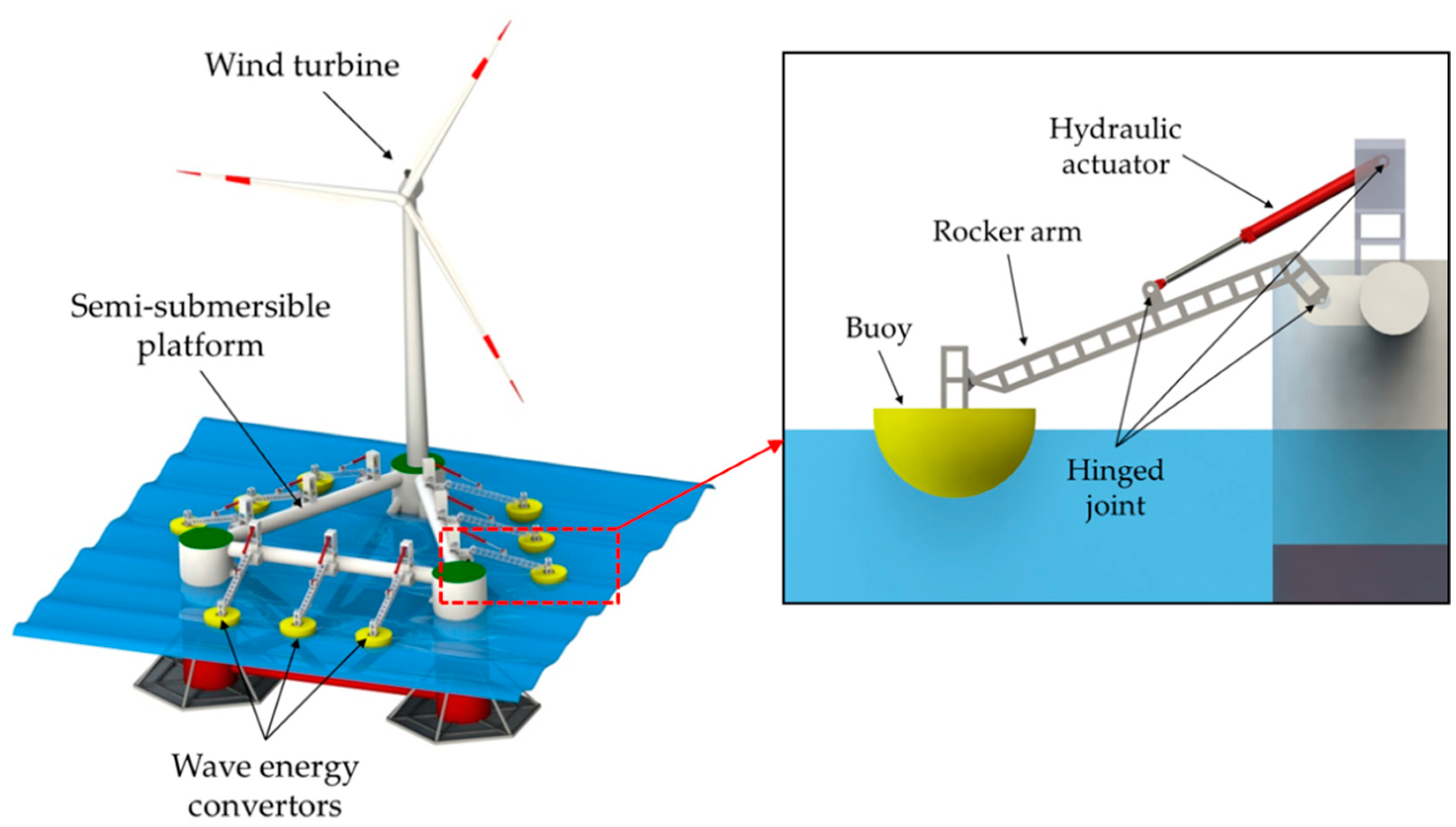
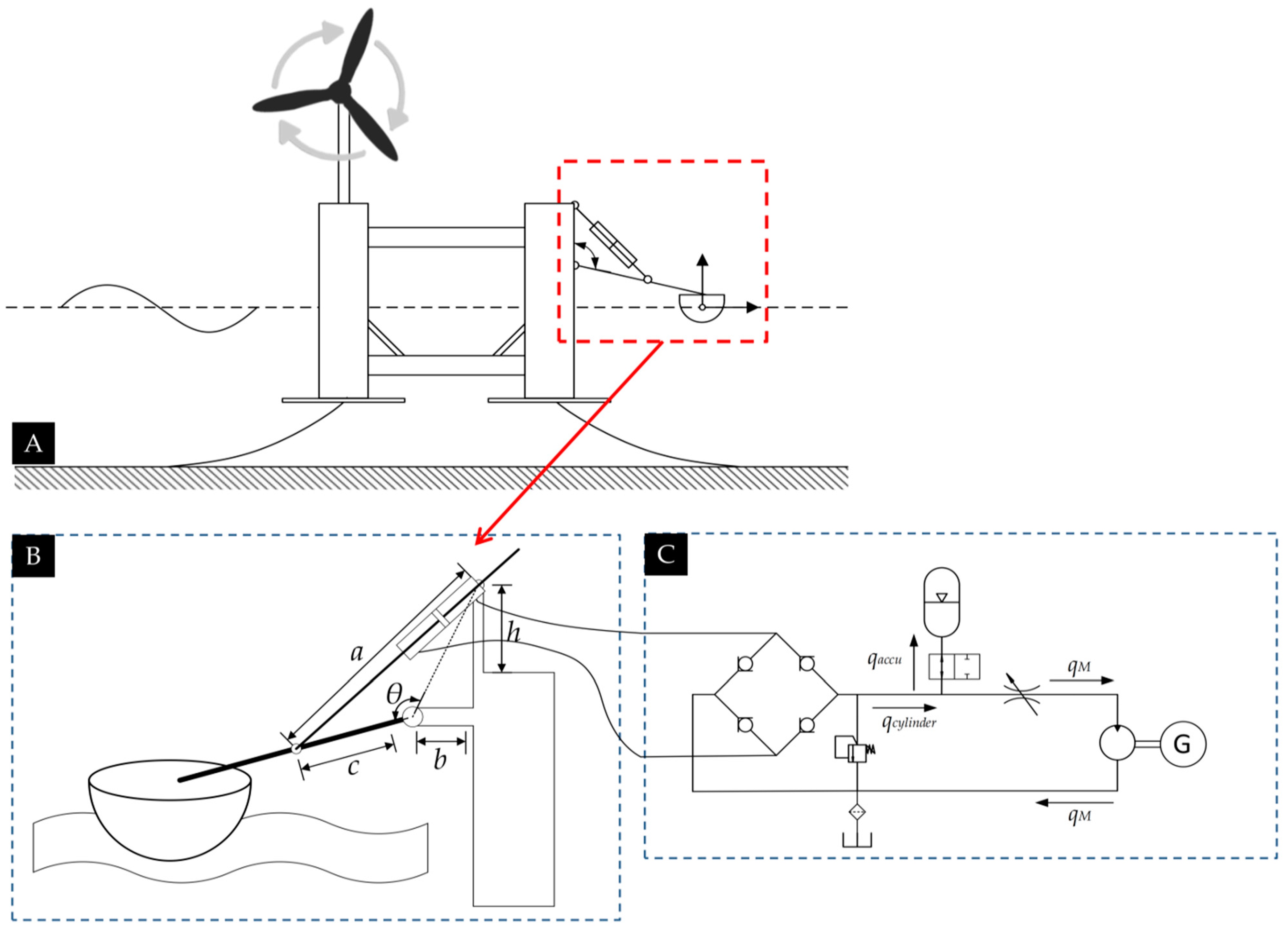
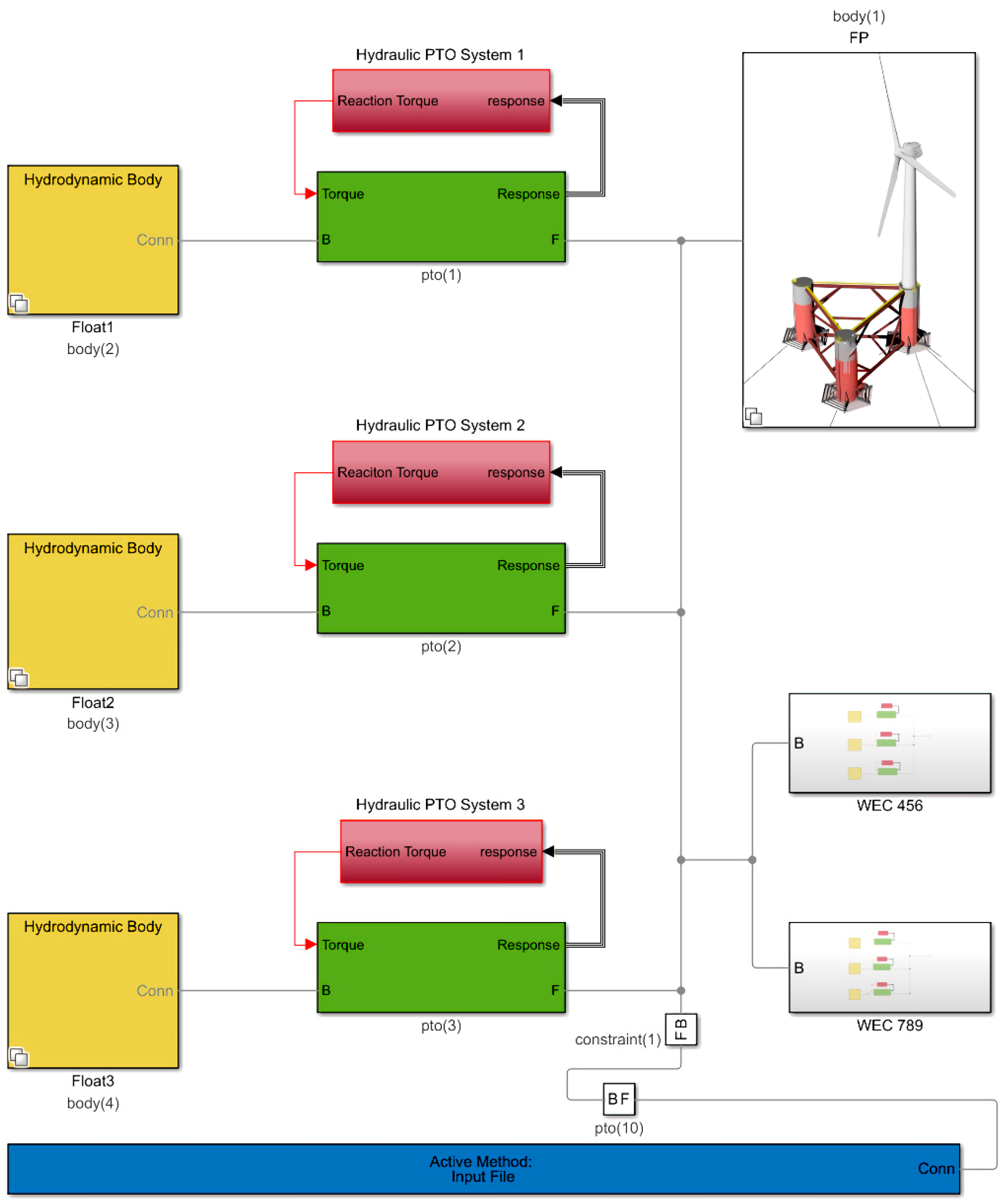

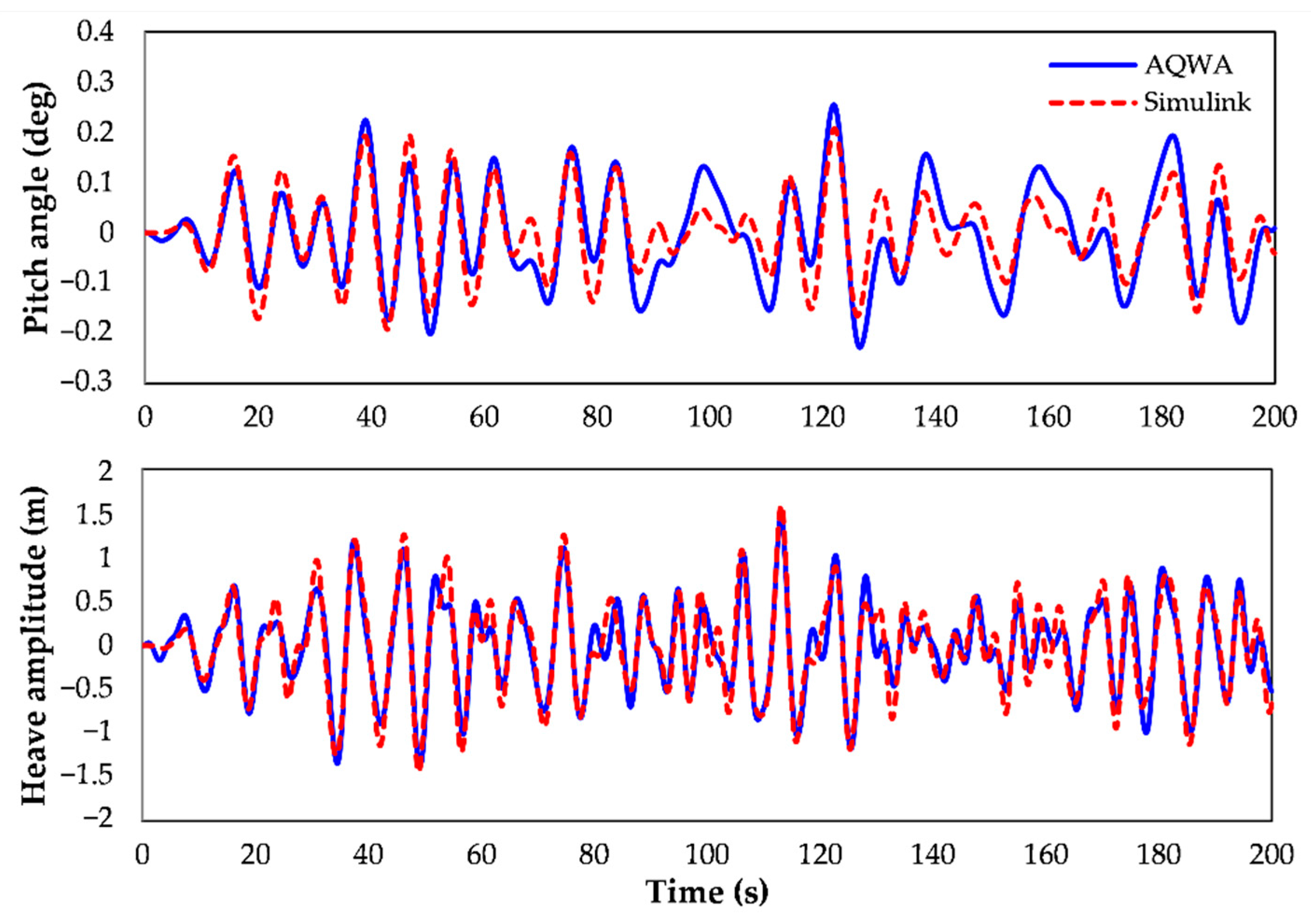
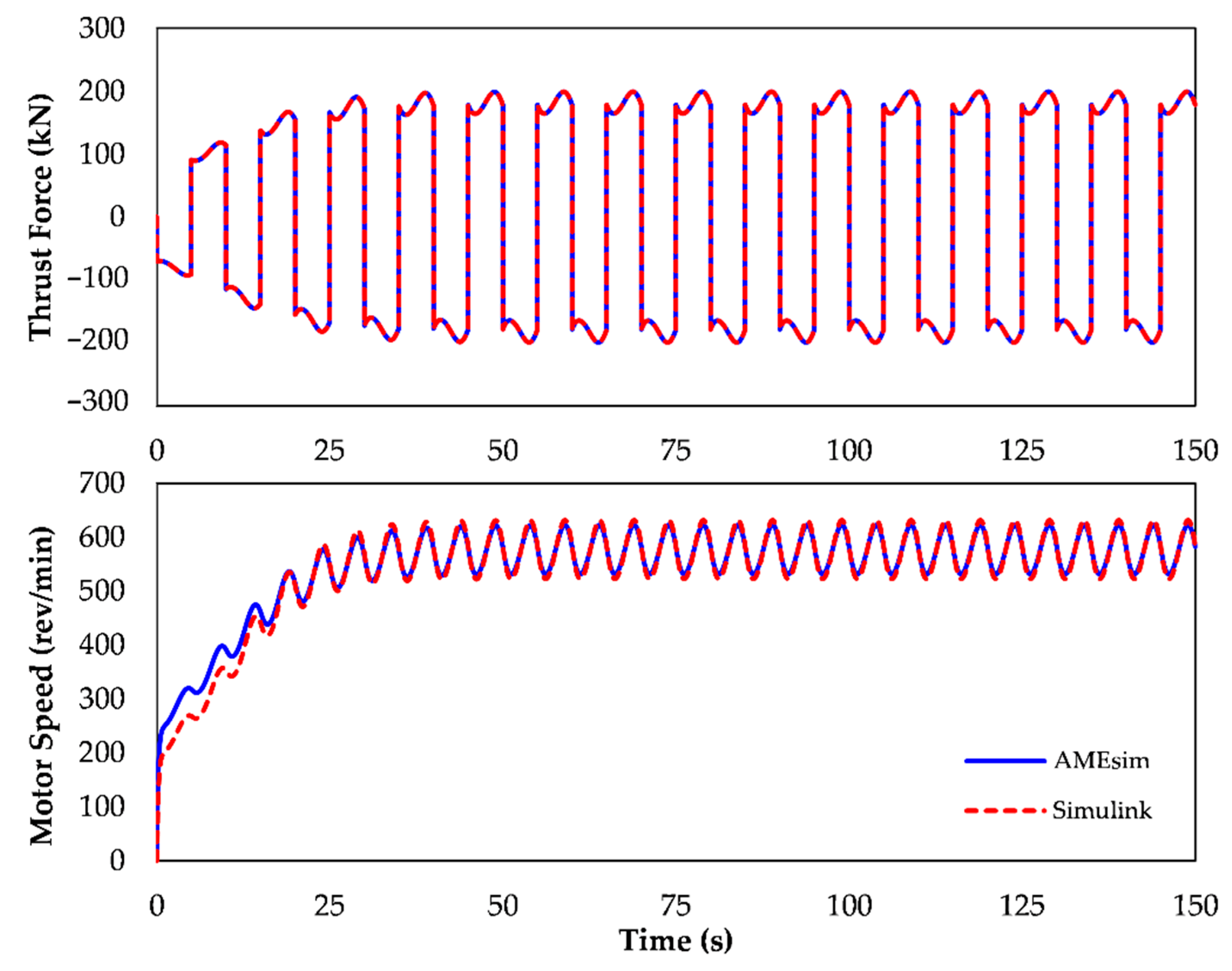
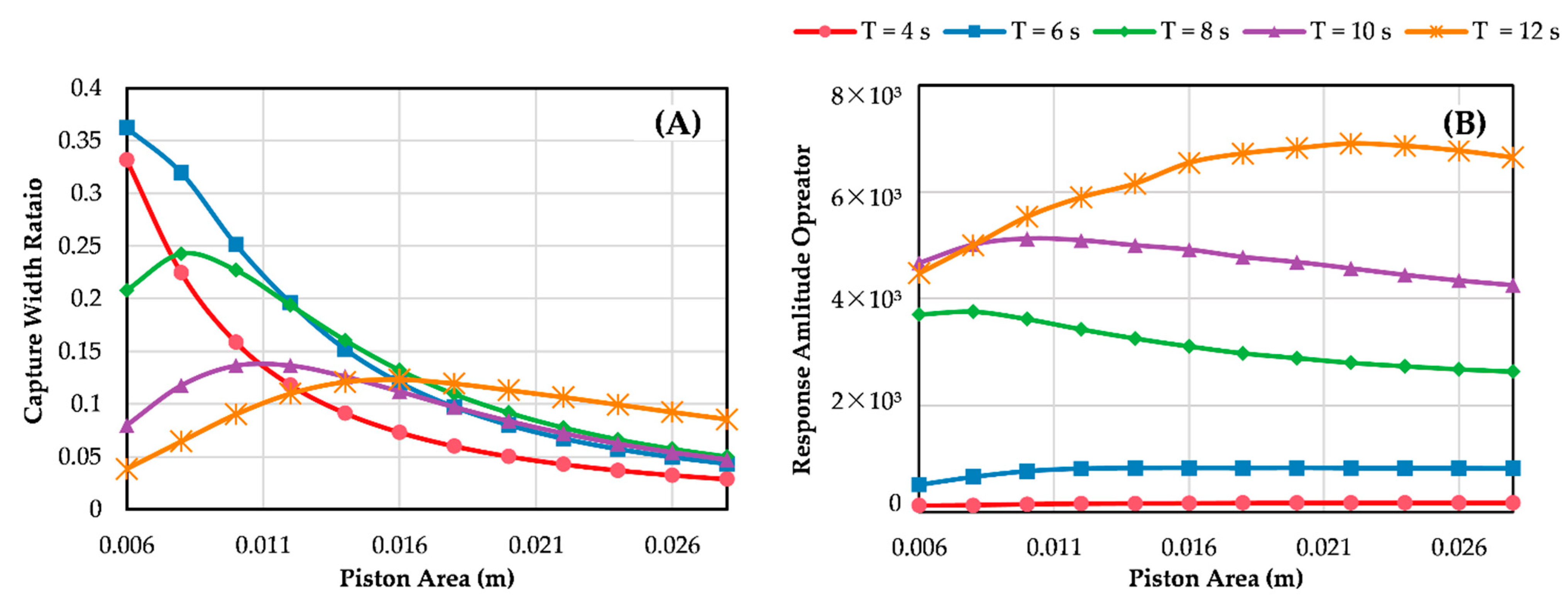


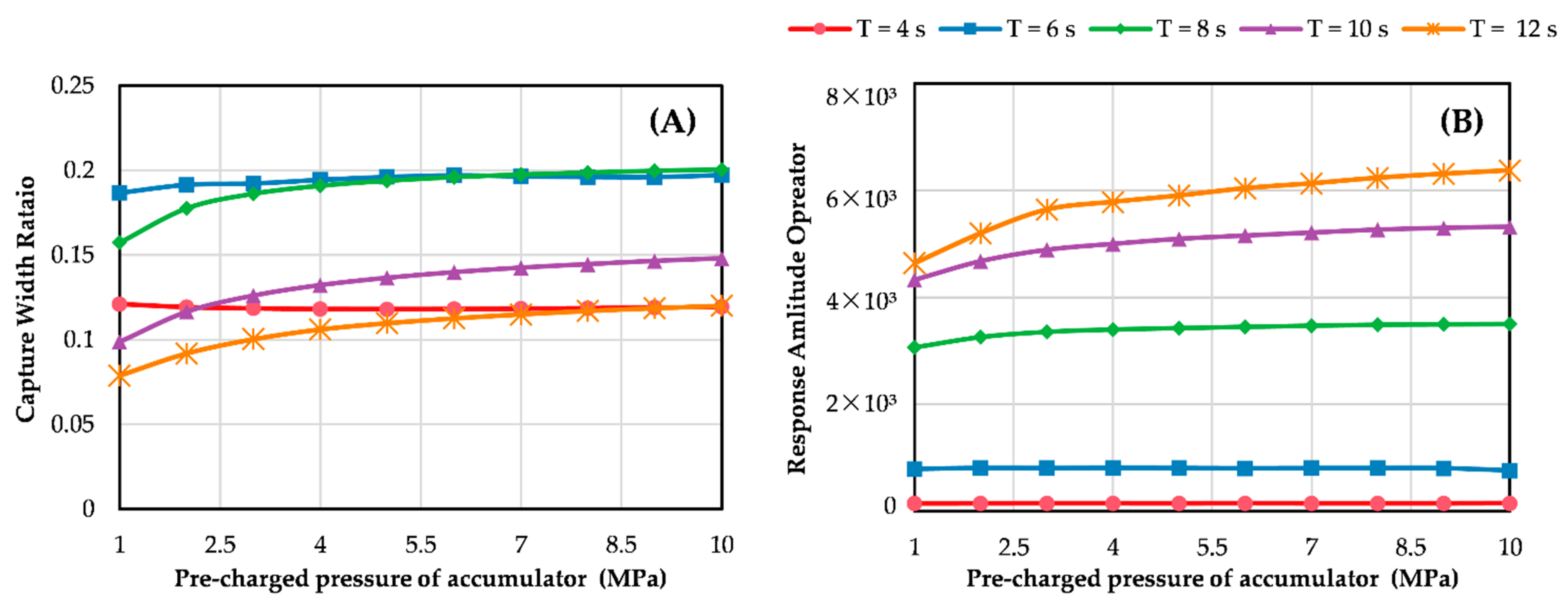
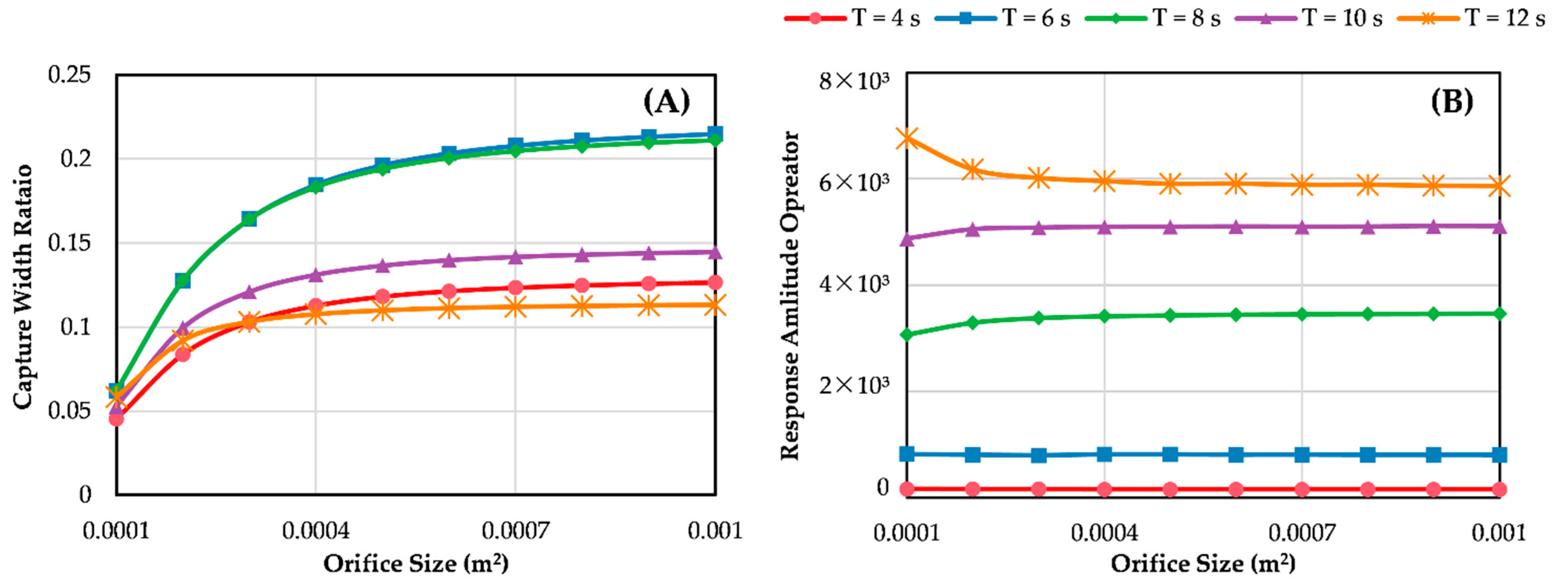

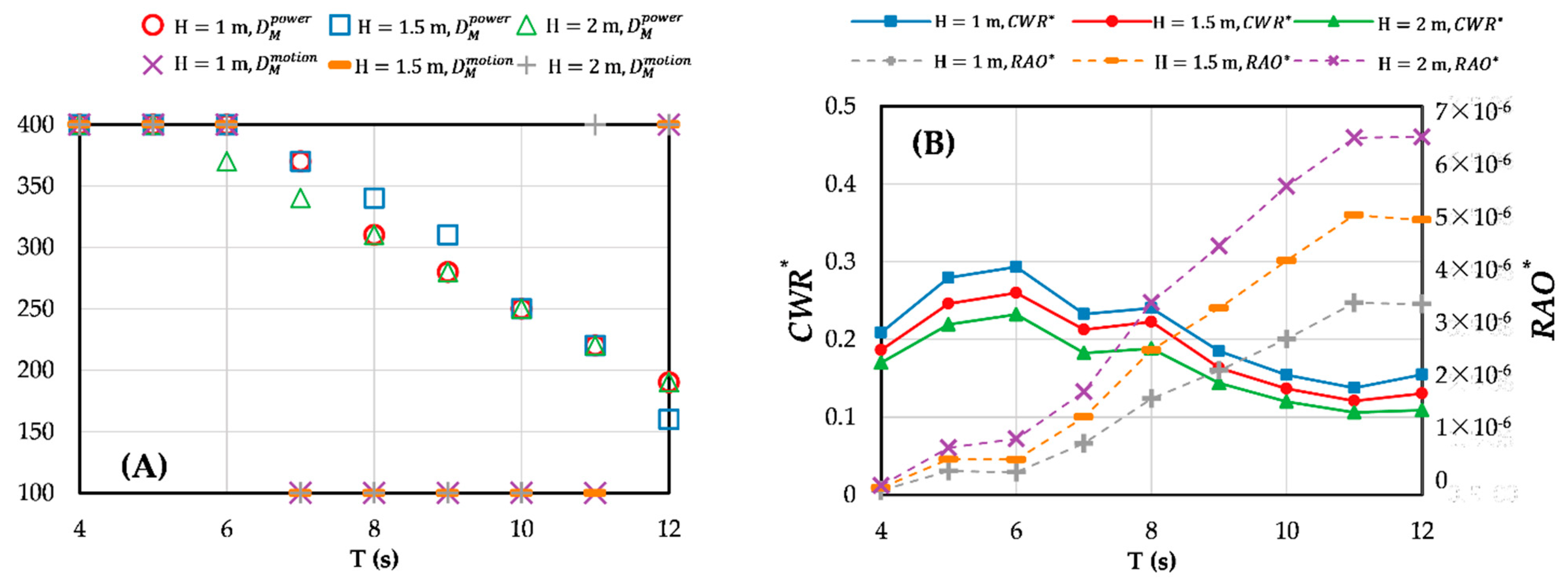
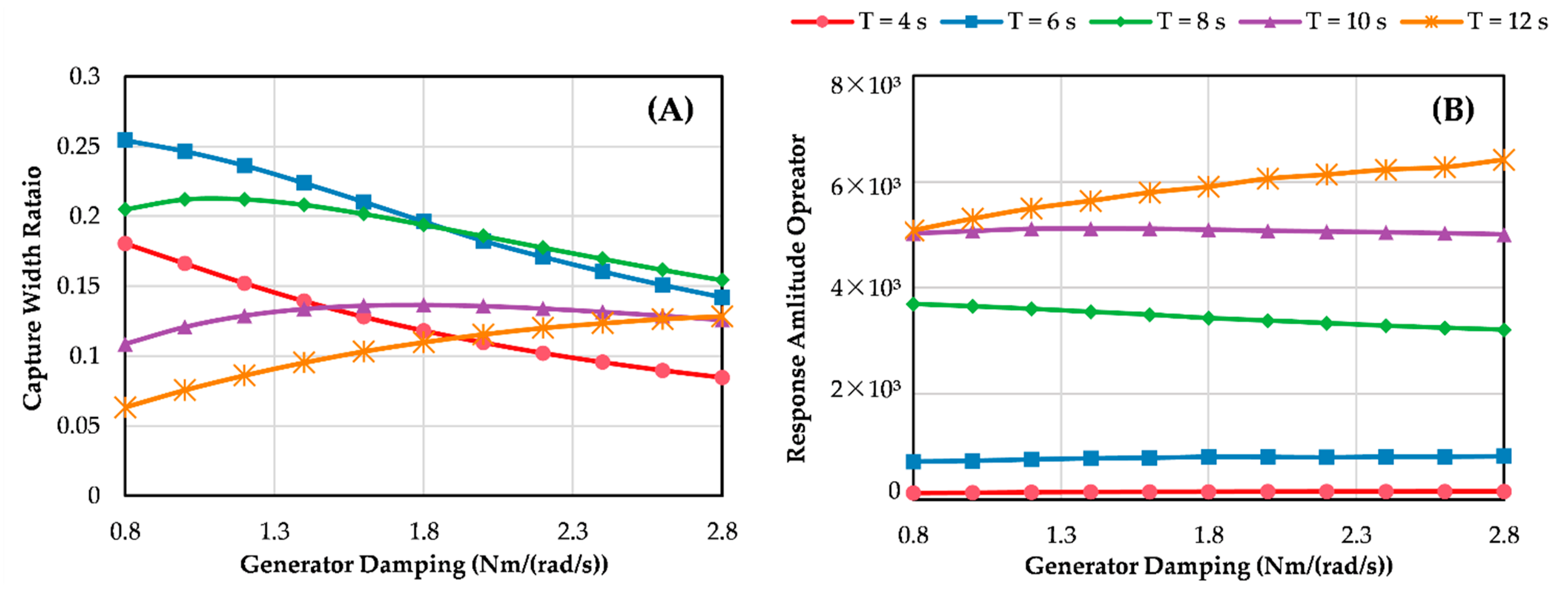
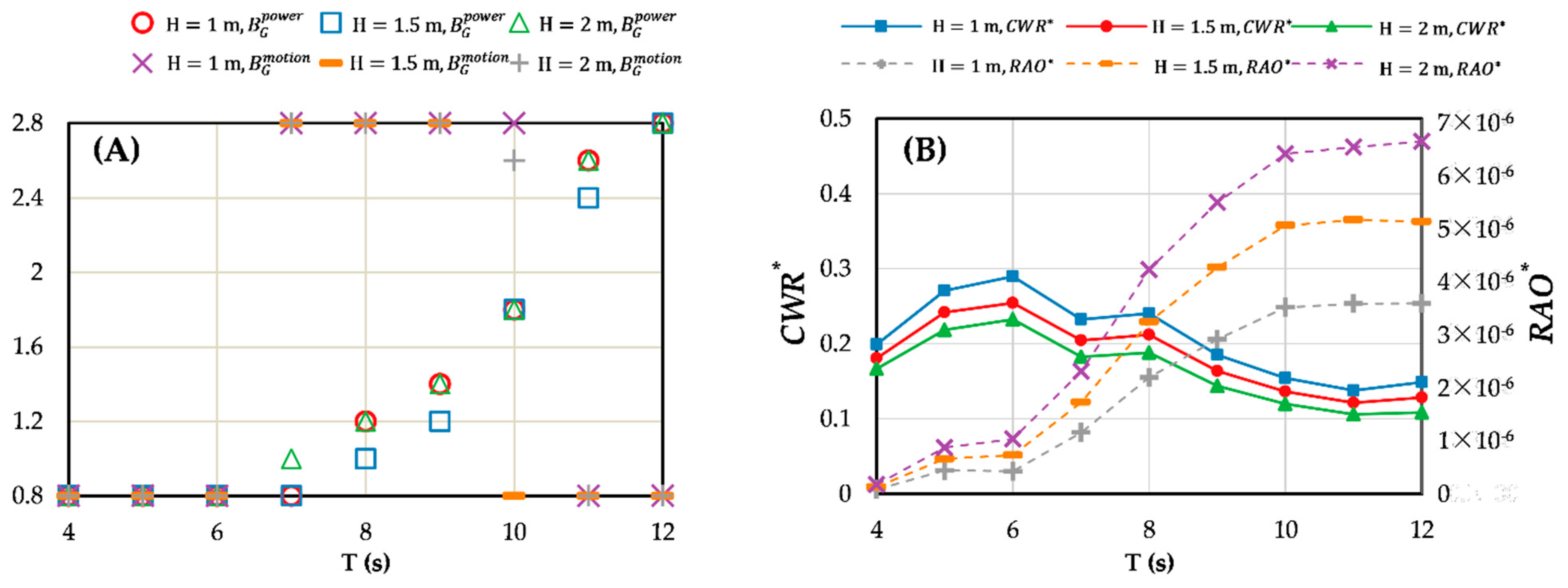
| Sea State | Wave Type | Wave Parameters | Value | Unit |
|---|---|---|---|---|
| Operational | Regular wave | Wave height | 1.5 | m |
| Period | 10 | s | ||
| Verification | Irregular wave | Significant wave height | 2 | m |
| Peak period | 8 | s | ||
| Spectrum type | Jonswap | / | ||
| Phase seed | 1 | / | ||
| Gamma | 3.3 | / | ||
| Regulating | Regular wave | Wave height | 1.0–2.0 | m |
| Period | 4–12 | s |
| Components | Parameters | Value | Unit |
|---|---|---|---|
| Floating Platform | Column diameter | 10.7 | m |
| Bracing diameter | 1.2 | m | |
| Pontoon diameter | 1.8 | m | |
| Distance between column center | 56.7 | m | |
| Column height | 33.6 | m | |
| Draft | 22.9 | m | |
| Vertical distance of center of gravity (below mean water surface line) | 8.9 | m | |
| Side length of hexagonal heave damping plate | 13.7 | m | |
| Thickness of heave plate | 0.1 | m | |
| Total displacement | 7.11 × 106 | kg | |
| Roll inertia about center of mass | 5.49 × 109 | kg·m2 | |
| Pitch inertia about center of mass | 5.49 × 109 | kg·m2 | |
| Yaw inertia about center of mass | 6.88 × 109 | kg·m2 | |
| Buoy | Diameter at mean water surface line | 5.27 | m |
| Draft | 2.59 | m | |
| Vertical distance of center of gravity (below mean water surface line) | −0.67 | m | |
| Total displacement | 2.76 × 104 | kg | |
| Roll inertia about center of mass | 4.75 × 104 | kg·m2 | |
| Pitch inertia about center of mass | 4.75 × 104 | kg·m2 | |
| Yaw inertia about center of mass | 6.19 × 104 | kg·m2 | |
| Rocker arm | Length of rocker arm, L | 16.28 | m |
| Initial length of hydraulic actuator, a | 12.47 | m | |
| Horizontal distance between rocker arm hinge point and support beam, b | 2 | m | |
| Distance between hinge point of hydraulic cylinder and hinge point of rocker arm, c | 8.14 | m |
| Components | Parameters | Default Value | Unit |
|---|---|---|---|
| Hydraulic Actuator | Piston diameter | 220 | mm |
| Rod diameter | 180 | mm | |
| Accumulator | Initial gas volume of accumulator | 30 | L |
| Pre-charged gas pressure of accumulator | 60 | bar | |
| Throttle Valve | Throttle valve coefficient | 1.35 × 10−5 | (m7/kg)0.5 |
| Orifice size of throttle valve | 0.0005 | m2 | |
| Hydraulic Motor and Electric Generator | Hydraulic motor displacement | 22.9 | cc/rev |
| Equivalent moment of inertia of hydraulic motor and electric generator | 2 | kg·m2 | |
| Equivalent damping of electric generator | 13.7 | N·m/rad/s |
| Investigation Parameters | Default Value | Investigation Ranges | Unit | |
|---|---|---|---|---|
| Ranges | Step | |||
| Piston area, | 0.01256 | 0.006–0.018 | 0.002 | m2 |
| Initial gas volume of accumulator, | 40 | 10–70 | 10 | L |
| Pre-charged gas pressure of accumulator, | 5 | 2–8 | 1 | MPa |
| Flow area of throttle valve, | 0.0005 | 0.0001–0.001 | 0.0001 | m2 |
| Hydraulic motor displacement, | 250 | 150–350 | 20 | cc/rev |
| Equivalent damping of electric generator, | 1.8 | 0.8–2.8 | N·m/rad/s | |
| Solver Parameters | Value | Unit |
|---|---|---|
| Solver Type | ode4 | / |
| Simulation Duration | 300 | s |
| Simulation Time-Step | 0.01 | s |
| Convolution Time | 15 | s |
| Wave Ramp Time Length | 30 | s |
Publisher’s Note: MDPI stays neutral with regard to jurisdictional claims in published maps and institutional affiliations. |
© 2022 by the authors. Licensee MDPI, Basel, Switzerland. This article is an open access article distributed under the terms and conditions of the Creative Commons Attribution (CC BY) license (https://creativecommons.org/licenses/by/4.0/).
Share and Cite
Wang, Y.; Huang, S.; Xue, G.; Liu, Y. Influence of Hydraulic PTO Parameters on Power Capture and Motion Response of a Floating Wind-Wave Hybrid System. J. Mar. Sci. Eng. 2022, 10, 1660. https://doi.org/10.3390/jmse10111660
Wang Y, Huang S, Xue G, Liu Y. Influence of Hydraulic PTO Parameters on Power Capture and Motion Response of a Floating Wind-Wave Hybrid System. Journal of Marine Science and Engineering. 2022; 10(11):1660. https://doi.org/10.3390/jmse10111660
Chicago/Turabian StyleWang, Yuanzhi, Shuting Huang, Gang Xue, and Yanjun Liu. 2022. "Influence of Hydraulic PTO Parameters on Power Capture and Motion Response of a Floating Wind-Wave Hybrid System" Journal of Marine Science and Engineering 10, no. 11: 1660. https://doi.org/10.3390/jmse10111660
APA StyleWang, Y., Huang, S., Xue, G., & Liu, Y. (2022). Influence of Hydraulic PTO Parameters on Power Capture and Motion Response of a Floating Wind-Wave Hybrid System. Journal of Marine Science and Engineering, 10(11), 1660. https://doi.org/10.3390/jmse10111660







